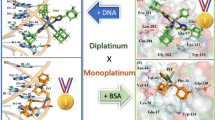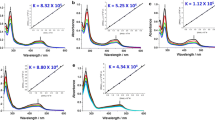Abstract
The interactions between a series of platinum complexes, including (pyridyl)(6-phenyl-2,2′-bipyridine)platinum(II) hexafluorophosphate (1), three dinuclear bis[(6-phenyl-2,2′-bipyridine)platinum(II)] complexes (2–4), and (4-aminopyridine)(4,6-diphenyl-2,2′-bipyridine)platinum(II) perchlorate (5) with DNA have been investigated. All Pt(II) complexes, except 5, were demonstrated to be DNA intercalators, based on viscosity measurements. Absorption and fluorescence titration results indicated that the addition of a phenyl ring to the 6-phenyl-2,2′-bipyridine ligand dramatically reduced the DNA binding of the Pt(II) complex 5. The dinuclear complexes 2–4 exhibited multiple binding modes of mono/bisintercalation and groove binding, as revealed by viscosity and fluorescence titration measurements. While complexes 2–4 bound to DNA with significantly enhanced affinities as compared to 1, compounds 1 and 2–4 showed similar IC50 values against a panel of cancer cell lines. In addition, these complexes showed similar cellular uptakes. The results indicated that the cytotoxicity of these (6-phenyl-2,2′-bipyridine)platinum compounds may not be mediated through DNA binding but may involve interacting mechanisms with cellular components other than DNA.





Similar content being viewed by others
Abbreviations
- AO:
-
acridine orange
- ampy:
-
4-aminopyridine
- bipy:
-
2,2′-bipyridine
- bp:
-
base pair
- CNN:
-
6-phenyl-2,2′-bipyridine
- ctDNA:
-
calf thymus DNA
- EB:
-
ethidium bromide
- EI:
-
electron ionization
- en:
-
ethylenediamine
- FAB:
-
fast atomic bombardment
- H33342:
-
Hoechst 33342
- IC50 :
-
inhibitory concentration 50%
- ICP-AES:
-
inductively coupled plasma–atomic emission spectroscopy
- MTT:
-
3-(4,5-dimethylthiazol-2-yl)-2,5-tetrazolium bromide
- 4-PhCNN:
-
4,6-diphenyl-2,2′-bipyridine
- phen:
-
1,10-phenanthroline
- terpy:
-
2,2′:6′,2″-terpyridine
- Tris:
-
tris(hydroxymethyl)aminomethane
References
Kratz F, Schütte MT (1998) Cancer J 11:176–182
Erkkila KE, Odom DT, Barton JK (1999) Chem Rev 99:2777–2795
Wakelin LPG, McFadyen WD, Walpole A, Roos IAG (1984) Biochem J 222:203–215
McFadyen WD, Wakelin LPG, Roos IAG, Hillcoat BL (1987) Biochem J 242:177–183
Friedman AE, Chambron JC, Sauvage JP, Turro NJ, Barton JK (1990) J Am Chem Soc 112:4960–4962
Lai SW, Chan MCW, Cheung TC, Peng SM, Che CM (1999) Inorg Chem 38:4046–4055
Dervan PB, Becker MM (1978) J Am Chem Soc 100:1968–1970
Valentini L, Nicolella V, Vannini E, Menozzi M, Penco S, Arcamone F (1985) Farmaco 40:377–390
Chaires JB, Leng F, Przewloka T, Fokt I, Ling YH, Perez-Soler R, Priebe W (1997) J Med Chem 40:261–266
Dervan PB (1986) Science 232:464–471
Sambrook J, Fritsch EF, Maniatis T (eds) (1989) Molecular cloning: a laboratory manual. Cold Spring Harbor Laboratory Press, New York
Barton JK, Goldberg JM, Kumar CV, Turro NJ (1986) J Am Chem Soc 108:2081–2088
Dietrich-Buchecker CO, Marnot PA, Sauvage JP (1982) Tetrahedron Lett 23:5291–5294
Constable EC, Henney RPG, Leese TA, Tocher DA (1990) J Chem Soc Dalton Trans 443–449
Constable EC, Henney RPG, Leese TA, Tocher DA (1990) J Chem Soc Chem Commun 513–515
Chan HL, Ma DL, Yang M, Che CM (2003) ChemBioChem 4:62–68
Yip JHK, Suwarno, Vittal JJ (2000) Inorg Chem 39:3537–3543
Kumar CV, Asuncion EH (1993) J Am Chem Soc 115:8547–8553
Suh D, Chaires JB (1995) Bioorg Med Chem 3:723–728
Chaires JB, Dattagupta N, Crothers DM (1982) Biochemistry 21:3933–3940
McGhee JD, von Hippel PH (1974) J Mol Biol 86:469–489
McGhee JD (1976) Biopolymers 15:1345–1375
Mosmann T (1983) J Immunol Methods 65:55–63
Spector DL, Goldman RD, Leinwand LA (eds) (1998) Cells: a laboratory manual, vol 1. Cold Spring Harbor Laboratory Press, New York
Long EC, Barton JK (1990) Acc Chem Res 23:271–273
Leng F, Priebe W, Chaires JB (1998) Biochemistry 37:1743–1753
King HD, Wilson WD, Gabbay EJ (1982) Biochemistry 21:4982–4989
Cohen G, Eisenberg H (1969) Biopolymers 8:45–55
Hanada T, Isobe H, Saito T, Ogura S, Takekawa H, Yamazaki K, Tokuchi Y, Kawakami Y (1998) Cancer 83:930–935
Schwartzman RA, Cidlowski JA (1993) Endocrinol Rev 14:133–151
Vermes I, Haanen C (1994) Adv Clin Chem 31:177–246
Van Furth R, Van Zwet TL (1988) J Immunol Methods 108:45–51
Savill JS, Henson PM, Henson JE, Haslett C, Walport MJ, Wyllie AH (1989) J Clin Invest 83:865–875
Thornberry NA, Lazebnik Y (1998) Science 281:1312–1316
Wyllie AH (1980) Nature 284:555–556
Acknowledgements
This work was supported by the Hong Kong Research Grants Council (CityU 1189/01P, CityU project no. 9040652), and the Area of Excellence Scheme, University Grants Committee (Hong Kong).
Author information
Authors and Affiliations
Corresponding authors
Electronic Supplementary Material
Rights and permissions
About this article
Cite this article
Chan, HL., Ma, DL., Yang, M. et al. Bis-intercalative dinuclear platinum(II) 6-phenyl-2,2′-bipyridine complexes exhibit enhanced DNA affinity but similar cytotoxicity compared to the mononuclear unit. J Biol Inorg Chem 8, 761–769 (2003). https://doi.org/10.1007/s00775-003-0477-0
Received:
Accepted:
Published:
Issue Date:
DOI: https://doi.org/10.1007/s00775-003-0477-0




